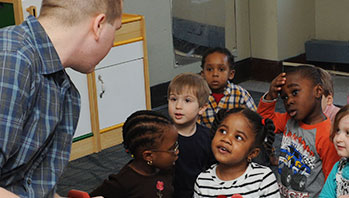- glass
- live flowering plants that have visible seeds
- magnifying lens
- red food coloring
- water
- white flower with a stem (such as a white carnation)
- flower
- garden
- grow
- plant
- root
- seed
- stem
MA Standards:
English Language Arts/Speaking and Listening/SL.PK.MA.1a: Observe and use appropriate ways of interacting in a group (e.g., taking turns in talking, listening to peers, waiting to speak until another person is finished talking, asking questions and waiting for an answer, gaining the floor in appropriate ways).
MA Draft STE Standards
Life Sciences/Ecosystems; Biological Evolution/LS2/4.B: Using their experiences in the local environment and other evidence, raise and discuss questions about the basic needs of familiar organisms and how they might meet their needs. (Clarification statement: basic needs include water, food, air, shelter, and light for most plants)
Life Sciences/From Molecules to Organisms: Inheritance and Variation of Traits/LS1/3.A: Describe/draw and compare the body parts of animals (including themselves) and plants they are investigating [System] and explain functions of some of the observable body parts. [Structure and Function]
Head Start Outcomes:
Science Knowledge/Conceptual Knowledge of Natural and Physical Worlds: Observes, describes, and discusses living things and natural processes.
Science Knowledge/Scientific Skills and Method: Collects, describes, and records information through discussions, drawings, maps, and charts.
PreK Learning Guidelines:
English Language Arts/Language 1: Observe and use appropriate ways of interacting in a group (taking turns in talking; listening to peers; waiting until someone is finished; asking questions and waiting for an answer; gaining the floor in appropriate ways).
Science and Technology/Life Sciences 10: Observe and identify the characteristics and needs of living things: humans, animals, and plants.
Talk Together: Flowers, Stems, and Roots

© Commonwealth of Massachusetts, Department of Early Education and Care (Jennifer Waddell photographer). All rights reserved.
STEM Key Concepts: Plants need water, food, and sunlight to grow; Plants have different parts: roots, stems, leaves, and fruit
ELA Focus Skills: Listening and Speaking, Vocabulary
Display the flowering plants. Ask children to tell about any gardens they saw on the way home from school yesterday or on the way to school today. Ask questions such as,
- What kind of plants did you see in the garden?
- Did any of the plants look like the plant we are growing? What was the same or different about them?
- How were the plants the same or different from the plants in the book Jack’s Garden?
Have children talk about the separate plant parts of the different plants and how each part helps the plant grow.
- Have children look at the flowering plant’s seed through a magnifying lens. Ask, How do you think the flower helps the plant? (produces the seed)
- Have children look at the roots. Ask, How do you think the roots help the plant? (hold plant into the ground; take in water and nutrients)
- Have children look at the stem. How do you think the stem helps the plant? (carries water and nutrients up the plant)
Direct children’s attention to the carnation. Say, Let’s see what happens the when we put this carnation with a long stem in a glass of water. Tell children that we wait to see what happens because, just like with our growing plants, some things take time.
- Pour water in a clear container until it is half full, then add food coloring and mix.
- Show children the carnation and help them identify the different parts. Ask, What do you think might happen if we put this carnation in the red water and leave it there all day? Record children’s predictions.
- Place the carnation in the container. Take a photo of the carnation to use tomorrow for comparison.
Social Emotional Tip: Asking children to predict helps build children’s ability to organize and express their own ideas.
English Language Learners: Help children grasp the phrase “traveling up.” Have a glass of water and a clear straw on hand to give children a visual reference for the phrase. Tell children that when you suck the water it travels up the straw to your mouth. Be sure to explain that water travels up a plant differently; plants do not suck up water like we do through a straw.
